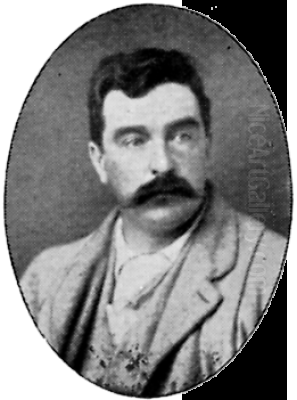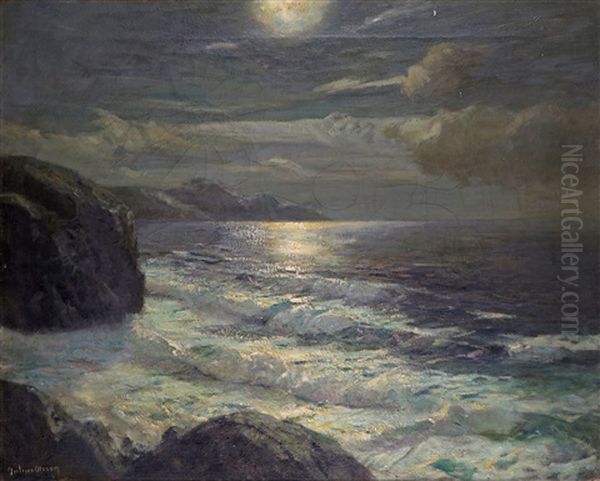
Julius Olsson stands as a significant figure in British art history, particularly renowned for his evocative marine paintings and his pivotal role in the development of the St Ives art colony in Cornwall. Born Albert Julius Olsson in Islington, London, on February 1st, 1864, he passed away on September 8th, 1942, in Dalkey, near Dublin, Ireland. His heritage was a blend of Swedish (from his father) and English (from his mother), a combination that perhaps contributed to his unique perspective on the landscapes and seascapes he would come to master. Though he did not pursue formal art training in the conventional sense, his innate talent and profound connection with the sea propelled him to become one of the most respected maritime artists of his generation.
Olsson's early life in London provided exposure to the burgeoning art scene, but his true artistic awakening seems tied to his experiences with the coast. He was largely self-taught, honing his skills through keen observation, practice, and studying the works of others in galleries. His passion was not confined to painting the sea; he was also an avid and experienced yachtsman. This practical, hands-on knowledge of the ocean – its moods, movements, light, and power – deeply informed his art, lending it an authenticity and dynamism that resonated with viewers and critics alike.
Early Career and the Move to Cornwall
Olsson began exhibiting his work in the late 1880s and early 1890s, initially showing in London venues. However, the dramatic coastline and unique quality of light in Cornwall soon beckoned. Around 1890, he made the decisive move to St Ives, a fishing town that was rapidly transforming into a vibrant hub for artists drawn by its picturesque scenery, affordable living, and the luminous coastal atmosphere. This move placed Olsson at the heart of what would become known as the St Ives School.

His arrival coincided with a growing artistic migration to West Cornwall, following the earlier establishment of the Newlyn School nearby, led by figures like Stanhope Forbes and Walter Langley. While the Newlyn artists often focused on figurative scenes of fishing life depicted with a 'plein air' realism, the St Ives artists, including Olsson, often placed a greater emphasis on landscape and seascape, exploring the effects of light and weather with a sometimes more decorative or atmospheric approach. Olsson quickly became a central and influential figure within the St Ives community.
He first exhibited work from Cornwall in 1897, and his presence helped solidify St Ives' reputation as a major art centre. He wasn't just a painter; he was an active community member, even contributing to the town's architecture, reportedly designing new buildings such as 'St Eia'. His studio became a focal point, and his enthusiasm for the local environment was infectious.
The Olsson School of Painting
Recognizing the need for structured training and wishing to share his passion and expertise, Olsson became a highly influential teacher. In 1895, alongside the artist Louis Grier, he established the Olsson School of Painting in St Ives. This school specialized in landscape and marine painting, attracting numerous aspiring artists to the town. Grier later left, and Algernon Talmage joined Olsson, though Olsson remained the principal driving force behind the school's ethos and direction.
Olsson's teaching methods were known for their rigour. He was a firm believer in direct observation and insisted that his students experience the landscape and seascape in all conditions. He would often take them out on sketching expeditions, sometimes aboard his own yacht, encouraging them to paint 'en plein air' regardless of the weather. This demanding approach aimed to instil a deep understanding of nature's forces and the fleeting effects of light and atmosphere.
His instruction, while challenging, was also highly regarded and deeply inspiring for many. He nurtured a generation of painters, equipping them with the technical skills and observational acuity needed to tackle the complexities of marine art. Among his notable students were the Australian-American Impressionist Richard Hayley Lever and the British painter John Anthony Park, both of whom achieved considerable success. His influence extended beyond his direct pupils, shaping the artistic direction of the St Ives colony during its formative years.
Artistic Style: Capturing the Sea's Essence
Julius Olsson is best celebrated for his mastery of marine painting. His work is characterized by a profound understanding of the sea's structure, movement, and reflective qualities. He possessed an exceptional ability to capture the transient effects of light on water, whether it was the dazzling sparkle of sunlight, the dramatic hues of a sunset, or, most famously, the ethereal glow of moonlight.
His style can be broadly described as Romantic Naturalism. While grounded in careful observation of nature, his paintings often evoke a powerful sense of atmosphere, mood, and the sublime power of the ocean. He employed fluid, confident brushwork, often using impasto to convey the texture of breaking waves or the shimmer of light on the water's surface. His palette could range from subtle greys and blues for stormy or misty conditions to vibrant oranges, pinks, and golds for sunsets, and deep indigos and silvers for his signature nocturnes.
While not strictly an Impressionist, Olsson clearly absorbed lessons from the movement regarding the depiction of light and colour. Like Claude Monet, he was fascinated by changing conditions and atmospheric effects. However, his work generally retains a stronger sense of structure and realism than that of the French Impressionists. His nocturnes, in particular, invite comparison with the atmospheric works of James McNeill Whistler, though Olsson's approach often involved more vigorous brushwork and a greater emphasis on the physical presence of the waves.
His deep, practical knowledge gained from sailing was crucial. He understood wave formation, the interplay of wind and water, and the subtle shifts in colour and reflection that characterized different times of day and weather conditions. This authenticity prevented his work from becoming merely decorative, grounding his romantic sensibilities in observed reality. He even authored a book, Notes on the Art of Marine Painting in Oil Colours (published around 1907-1909), sharing his technical insights.
Masterpieces and Recognition
Olsson's reputation grew steadily through regular exhibitions at major venues, including the Royal Academy of Arts in London, the Royal Institute of Oil Painters (ROI), the New English Art Club, and the Paris Salon. His work gained significant recognition both domestically and internationally.
One of his most famous and celebrated works is Moonlit Shore, exhibited at the Royal Academy in 1911. This painting exemplifies his skill in capturing the mystical beauty of the coast under moonlight. The interplay of light and shadow, the rendering of the waves breaking on the shore, and the overall atmospheric quality made a significant impact. The painting was purchased that same year by the Chantrey Bequest, a prestigious fund established to acquire works of art for the British nation, and it subsequently entered the collection of the Tate Gallery, cementing its status as a key work of the period.
Another notable painting, Stormy Evening on the Cornish Coast, showcases his ability to depict the more dramatic aspects of the sea. It captures the turbulence of rough weather, likely at sunset, combining dynamic wave action with intense colour, demonstrating his versatility in portraying the ocean's varied moods. His oeuvre contains numerous variations on these themes – storm-tossed seas, tranquil harbours, sunsets over the Atlantic, and countless moonlit nocturnes, each rendered with his characteristic vigour and sensitivity to light.
His achievements were formally recognized by the art establishment. He was elected an Associate of the Royal Academy (ARA) in 1914 and became a full Royal Academician (RA) in 1920. He also served as President of the Royal Institute of Oil Painters (ROI) from 1919 to 1924, a testament to the high regard in which he was held by his peers. Furthermore, he achieved international acclaim, winning two gold medals at the Paris Salon and receiving nominations for the prestigious Carnegie Prize in Pittsburgh.
Olsson and His Contemporaries
Olsson's career unfolded during a dynamic period in British art. He was a contemporary of the Newlyn School painters like Stanhope Forbes, Walter Langley, and Norman Garstin, whose focus on social realism and plein air techniques paralleled some aspects of his own practice, though his subject matter was more consistently focused on the sea itself. Within St Ives, he worked alongside and taught artists who contributed to the colony's distinct identity, such as Louis Grier, Algernon Talmage, John Anthony Park, and later figures associated with the area like Lamorna Birch.
His work can be situated within a broader tradition of British marine painting, looking back to the dramatic seascapes of J.M.W. Turner and the coastal studies of John Constable. The influence of Whistler's nocturnes on his moonlit scenes is also apparent, particularly in the emphasis on mood and tonal harmony. While primarily a British artist, his time spent exhibiting in Paris and his awareness of continental trends meant he was not working in isolation. The source material mentions connections or exhibitions alongside French masters like Manet, Gauguin, and Cézanne, and notes potential Fauvist influences in his use of colour, suggesting an awareness of Post-Impressionist developments, even if his own style remained rooted in a form of naturalism.
His relationship with Grier and Talmage in the running of the school was primarily collaborative, though Olsson was clearly the senior partner and guiding influence. There's little evidence of direct rivalry with specific major figures, though like any successful artist, he operated within a competitive exhibition system. His style, while popular, might have faced periods where it seemed less fashionable compared to emerging modernist trends in the early 20th century – the mention of an "ebb tide" in his career might refer to such shifts in critical or public taste, particularly as movements like Post-Impressionism and abstraction gained ground. However, his core reputation as a master of marine painting remained strong. Prominent portraitists like John Singer Sargent were also major figures in the RA during Olsson's time, representing a different facet of the established art world.
Later Life and Legacy
Olsson continued to paint and exhibit throughout his later career, although he eventually left St Ives. The reasons for his departure are not entirely clear, but changing circumstances and perhaps the shifting artistic landscape may have played a role. He spent his final years in Dalkey, County Dublin, Ireland, where he died in 1942 during the Second World War.
Julius Olsson's legacy is significant. He was arguably the pre-eminent British marine painter of the early 20th century, bringing a fresh vigour and atmospheric sensitivity to the genre. His depictions of the Cornish coast, particularly his moonlit scenes, remain iconic representations of that landscape and continue to be highly sought after. His technical skill, combined with his deep emotional connection to the sea, resulted in works that are both visually stunning and deeply evocative.
Beyond his own artistic output, his contribution to the St Ives art colony was crucial. Through his teaching and his dynamic presence, he helped establish the town as a major centre for art, laying the groundwork for future generations of artists who would find inspiration there, including the later modernists like Ben Nicholson and Barbara Hepworth who arrived in the following decades. While their abstract styles differed greatly from Olsson's naturalism, the artistic infrastructure and reputation he helped build contributed to St Ives' enduring importance.
His work is held in numerous public collections, including the Tate Britain, the Royal Academy of Arts, and various regional galleries in the UK and internationally. Julius Olsson remains a respected and admired figure, remembered for his passionate dedication to capturing the power and beauty of the sea, and for his formative influence on one of Britain's most enduring art colonies. His paintings continue to transport viewers to the windswept coasts of Cornwall, bathed in the dramatic light he so expertly rendered.